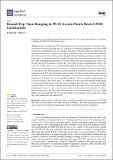Round-Trip Time Ranging to Wi-Fi Access Points Beats GNSS Localization
Author(s)
Horn, Berthold K. P.
Downloadapplsci-14-07805-v3.pdf (2.930Mb)
Publisher with Creative Commons License
Publisher with Creative Commons License
Creative Commons Attribution
Terms of use
Metadata
Show full item recordAbstract
Wi-Fi round-trip time (RTT) ranging has proven successful in indoor localization. Here, it is shown to be useful outdoors as well—and more accurate than smartphone code-based GNSS when used near buildings with Wi-Fi access points (APs). A Bayesian grid with observation and transition models is used to update a probability distribution of the position of the user equipment (UE). The expected value (or the mode) of this probability distribution provides an estimate of the UE location. Localization of the UE using RTT ranging depends on knowing the locations of the Wi-Fi APs. Determining these positions from floor plans can be time-consuming, particularly when the APs may not be accessible (as is often the case in order to prevent unauthorized access to the network). An alternative is to invert the Bayesian grid method for locating the UE—which uses distance measurements from the UE to several APs with known position. In the inverted method we instead locate the AP using distance measurements from several known positions of the UE. In localization using RTT, at any given time, a decision has to be made as to which APs to range to, given that there is a cost associated with each “range probe” and that some APs may not respond. This can be problematic when the APs are not uniformly distributed. Without a suitable ranging strategy, one can enter a dead-end state where there is no response from any of the APs currently being ranged to. This is a particular concern when there are local clusters of APs that may “capture” the attention of the RTT app. To avoid this, a strategy is developed here that takes into account distance, signal strength, time since last “seen”, and the distribution of the directions to APs from the UE—plus a random contribution. We demonstrate the method in a situation where there are no line-of-sight (LOS) connections and where the APs are inaccessible. The localization accuracy achieved exceeds that of the smartphone code-based GNSS.
Date issued
2024-09-03Department
Massachusetts Institute of Technology. Department of Electrical Engineering and Computer Science; Massachusetts Institute of Technology. Computer Science and Artificial Intelligence LaboratoryJournal
Applied Sciences
Publisher
Multidisciplinary Digital Publishing Institute
Citation
Horn, B.K.P. Round-Trip Time Ranging to Wi-Fi Access Points Beats GNSS Localization. Appl. Sci. 2024, 14, 7805.
Version: Final published version